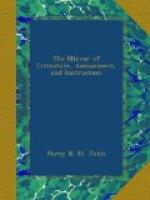Connecting the above sketch with one of the Fall of the Staubbach, in the Valley of Lauterbrun, in a former Mirror, (No. 403,) we may add, that the distance between the latter and Meyringen may also be performed in two days, amidst scenes, if possible, of sublimer character than the journey now described. From Lauterbrun across the Wengern Alp to the Valley of Grindenwald is the first day, the route passing in front of the Jungfrau, which throws up its magnificent ice-covered summits with more enchanting effect than the imagination can conceive. From Grindenwald, with its two fine glaciers, the path proceeds across the great Sheidech, by the baths of Rosenlaui, one of the most beautiful spots on this beautiful earth; and by the fall or rather falls, of the Rippenbach, (for there are no less than eleven in succession beneath each other,) to Meyringen.
We have thus pointed attention to a journey of four days, comprising the chief points in the Oberland, or Highlands, through this region of romantic wonders.
W.G.
* * * * *
THE SELECTOR; AND LITERARY NOTICES OF NEW WORKS.
* * * * *
THE EMPEROR’S ROUT.
Who does not remember the Butterfly’s Ball and the Grasshopper’s Feast in the halcyon days of their childhood? These toyful trifles, “light as air,” doubtless suggested the Emperor’s Rout. Do not start, expectant reader; this is no downfall of a royal dynasty, no burning of palaces, or muster of rebel ranks—no scamper “all on the road from Moscow”—or sauve qui peut at Waterloo; but a pleasant, little verse tale of the Emperor Moth inviting the haut ton of the Moths to a splendid rout—with notes intended as a tempting introduction to the fascinating study of entomology.
There are four Engravings: 1.—The Invitation, with the Emperor and the Empress, and the Buff-tip Moth writing the Cards.—2. The Dance, with the Sphinx Hippophaes, the Pease Blossom, the Mouse, the Seraph, Satellite, Magpie, Gold Spangle, Foresters, Cleap Wings, &c.—3. The Alarm.—4. The Death’s Head Moth. These are beautifully lithographed by Gauci. Their colouring, after Nature, is delightfully executed: the finish, too, of the gold-spangle is good, and the winged brilliancy of the company are exquisite pieces of pains-taking—sparkling as they are beneath a trellis-work rotunda, garlanded with roses, and lit with a pine-pattern lustre of perfumed wax. What a close simile could we draw of life from these dozen dancing creatures in their rainbow hues—their holiday and every-day robes—flitting through life’s summer, and then forgotten. Yet how fares it with us in the stream of life!
By the way, this trifle, though so prettily coloured, is in price what was once called “a trifle”—yet what kings and queens have often quarrelled for—half-a-crown.




